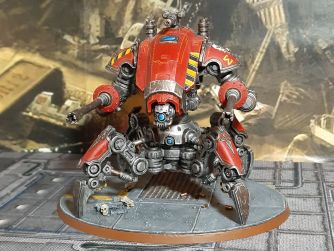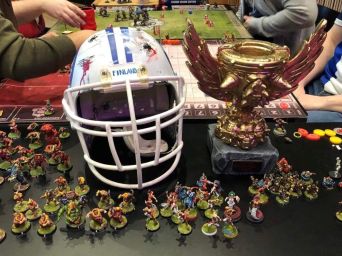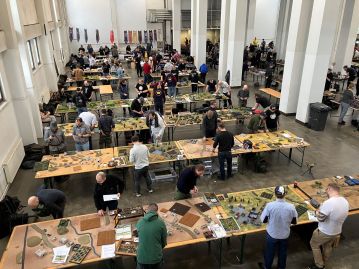Miniatures game or figure hobby culture
| Miniatures game or figure hobby culture | ||||
|---|---|---|---|---|
| In the national inventory | ||||
|

Practitioners and people who know the tradition well
In Finland, there are thousands of miniatures gaming enthusiasts, often referred to as "figupeli" (figu game) in Finnish enthusiasts. Due to the nature of the hobby, it's impossible to provide an exact number of participants. The community of enthusiasts is diverse in terms of backgrounds: some have just started, some have been into it for decades, and some have returned to the hobby in adulthood, revisiting a childhood or adolescent pastime. Additionally, the tradition has been passed down to the next generation in some families.
Miniatures gaming hobby encompasses various aspects, and individuals can pursue it in various ways. Collaboration and social interaction are integral to the hobby. While building and painting figures can be done individually, digital platforms (websites, social media, streaming services) have increased opportunities for communal activities in these areas as well. In many locations, there are hobby groups and communities that vary from informal groups of a few people to large, registered associations with tens or hundreds of members. Apart from gaming clubs or hobby groups, the internet hosts numerous online communities and groups. Some of these are established for local enthusiasts to communicate, while others serve as national or international platforms to support the hobby. Enthusiasts may belong to several different groups simultaneously, where they share images of their creations, discuss the practice, seek gaming partners, or buy and sell game-related items. In addition to Finnish groups, many enthusiasts are also part of international communities. Within this culture, there are various subgroups that may emphasize different aspects, such as painting, gaming, or themes related to the hobby (history, sci-fi, fantasy). However, these enthusiasts or subgroups share the broader umbrella of the miniatures gaming hobby.

Practising of the tradition
Miniatures games, often referred to as "figupelit" in Finnish, are a versatile hobby. They involve building, painting, and collecting game characters, playing with those characters, exploring the backgrounds and worlds of games, and various forms of design, including creating one's own game characters, often starting with writing background stories. Some enthusiasts focus solely on building and painting, some exclusively on playing, but generally, the hobby encompasses multiple of these aspects. As the name suggests, miniatures are miniature model figures. Unlike traditional miniature models, these figures are also used as gaming pieces. They are used to play various types of battle games, which can be set in historical, futuristic, or fantasy worlds. Many role-playing game enthusiasts also use miniatures when playing tabletop role-playing games. The hobby of miniatures gaming combines elements of various other hobbies, including traditional miniature model building and craftsmanship, board or role-playing style gaming, and elements of science fiction, fantasy, or historical themes.
Typically, miniature figures are assembled from ready-made parts. Nowadays, figures are primarily made of plastic, but depending on the manufacturer, they can also be metallic or resin. With 3D printing, it's also possible to create and print figures for use in the hobby. Some enthusiasts may even sculpt their figures entirely from scratch using modeling clay or 3D modeling software.

Miniatures' packages usually come with instructions for assembling the figures. However, there is no prohibition against modifying, or ”converting” figures. At its simplest, converting could involve swapping out one part for another. Some hobbyists find converting to be the most interesting aspect of the hobby and may combine parts from several different figures to create unique and customized miniatures.
Following assembly, miniatures are typically painted. While not essential for gameplay, the hobby is inherently visual. There are many different painting styles, and miniatures are usually painted with brushes using acrylic paints designed for figures. In addition to self-learning, the culture also includes seeking advice from fellow hobbyists through collaborative painting, online inquiries, reading, or instructional videos. Sharing one's expertise and offering guidance to others is also part of the hobby community.
Not all miniatures are intended for gaming purposes. Some hobbyists, for example, paint dioramas or busts, both of which can be considered decorative or art pieces. Additionally, not all hobbyists are interested in painting; some may leave their figures unpainted or have them painted professionally for a fee. Furthermore, in some games, figures are sold pre-painted. However, some enthusiasts prefer to customize even these figures to their liking.
Miniatures come in various scales. The most common scale is in the range of 28-32 millimeters, where the height of a human-sized figure is about 3 centimeters. However, figures can be smaller or larger than this, with human figures potentially being only a few millimeters tall in the smallest scales. In some games, there may be only a few figures in use, while others may involve hundreds or even thousands. Games have their own rules, similar to board games. Miniatures games generally differ from board games in that they often use separate, purchased, or self-constructed game boards as a playing area instead of a board. These gaming boards can include forests, hills, ruins, caves, or space stations, depending on the game's theme. Typically, games involve conflict since conflict creates an engaging and easily understandable premise. Often, dice are used in games to determine the outcomes of battles. Dice or various card decks introduce randomness to games, adding a luck element alongside skill. Apart from dedicated miniatures games, there are also board games that use miniatures as game pieces. The distinction from dedicated miniature games is not always clear. Additionally, many tabletop role-playing games use miniatures as character representations. However, miniatures games are not role-playing games, even though some games may have role-playing elements, such as character progression between games or during them.
Miniatures games can be played in various ways. Games can be played as individual battles, but they can also include storytelling and link multiple games into campaigns. Competitive gaming in leagues and tournaments is also popular. Gaming events provide an excellent opportunity to meet other hobbyists and find new gaming partners.
The background and history of the tradition
The most well-known miniatures games are Warhammer, with a fantasy theme, and Warhammer 40000, with a sci-fi theme. These games have generated thousands of pages of background lore, hundreds of novels, multiple computer and console games, and even a movie. Of course, there are many other options with different fantasy and sci-fi themes, as well as various historical eras. The games vary in terms of how much preparation, terrain, or different characters they require, the rules they use, and the amount of time it takes to play one game. In Finland, enthusiasts of modern, commercially-produced miniatures games have been present since the 1980s. However, even earlier, miniature figures, referred to as plastic soldiers or simply miniatures, were used for wargaming. This type of miniatures gaming has deep roots, especially within the military and among military history enthusiasts. For example, the Finnish Game Museum features Reijo Paulus's wargame from the 1950s, and the Finnish National Museum has games like "Laivastopeli" (Naval Game), which was played as early as the 1940s. The hobby gained broader popularity in the 1990s and 2000s, particularly with the widespread popularity of Warhammer and Warhammer 40000 games among gaming enthusiasts. Although it is a distinct hobby, miniatures and miniatures gaming have been closely associated with role-playing in Finland throughout their history, including the use of miniatures in games like Dungeons & Dragons and other role-playing games. This hobby has been visible at various gaming events since the 1990s. The annual role-playing game event "Ropecon" has included a significant amount of content related to miniatures gaming, such as game tournaments, painting workshops and competitions, as well as lectures, since 1994.
Within the hobby, various competitions related to painting and gaming are organized both in Finland and internationally, and various awards are distributed. Finnish enthusiasts have also achieved success in these competitions on the international stage: Tuomas Lähdeoja won the Warhammer 40000 miniatures game "World Championship" or Grand Tournament in England in 1999 and 2001, while Mikael Silvanto and Miika Bergdahl have won trophies in the international Golden Daemon painting competition. Additionally, in 2020, Mika Joensuu received international recognition as a Warhammer Hero for promoting the hobby in diverse ways and utilizing it in youth work.
The transmission of the tradition
There are various gaming groups and communities throughout Finland, and many of them are open to new enthusiasts. These hobby groups provide opportunities for individuals to try out the hobby and receive guidance on different aspects of it.
In Finland, several gaming events are organized annually, featuring programs related to miniatures gaming, such as game tournaments, painting competitions, and workshops. These events aim to provide meeting places for enthusiasts while also increasing awareness of the hobby and encouraging both new and returning enthusiasts to participate.
Some libraries and youth centers also host miniatures gaming activities or related (art) exhibitions, hobby clubs, and workshops. Due to the versatility of the hobby, it is well-suited for organized club activities for children and young people. In larger cities, there are hobby shops that sell gaming supplies, and in addition to purchasing miniatures and accessories, enthusiasts can also get assistance with starting the hobby. Many hobby shops offer opportunities to play practice games or receive guided instruction on assembling and painting figures, allowing individuals to try out the hobby before acquiring their own materials. Some hobby shops also provide gaming spaces and opportunities to find gaming partners, effectively becoming gathering places for local enthusiasts.
The miniatures gaming hobby culture also has an active international dimension through various online groups and social media channels. In recent years, Finland has increasingly participated in international gaming tournaments around the world, and international players have been involved in domestic major events.
The future of the tradition
The miniatures gaming hobby culture has successfully evolved over the years in line with technological advancements, leveraging the internet, social media, and the possibilities offered by 3D printing. While the hobby utilizes digital tools, it also serves as a counterbalance to our increasingly digitized society by providing an opportunity to engage in something tangible and craft-oriented. In recent years, the hobby has benefited from increased visibility in the media, especially through its most well-known games like Warhammer and Warhammer 40000. Digital games have been created based on these gaming worlds, plans for a TV series are in the works, and many public figures have openly stated their involvement in miniatures gaming.
A significant portion of miniatures gaming enthusiasts are adults. To ensure the continued growth of the hobby, it's important to attract new enthusiasts from younger generations. Promoting various gaming events and youth hobby clubs is crucial for the future of the hobby in this regard.
The community/communities behind this submission
Etelä-Karjalan Miniatyyrikilta Ry
Figuprojektien vertaisryhmä -harrastusyhteisö
Hyvinkää-Uusimaa Blood Bowl League (HUBBLe)
Kajaanin rooli- ja lautapeliyhdistys Karly RY
Mordheim-yhteisö / Tuomas Pirinen
Pöllökarhut ry - Porin Pöytäpeliseura
Bibliography and links to external sources of information
Figukirppis (figure thrift shop), Facebook group
Figuprojektien vertaisryhmä, Facebook group
Sotavasara.net, -forum
Wikipedia: Miniatyyripeli
Wikipedia: Ropecon
Bibliography:
Joensuu, Mika 2014. Joukkoistaminen ja verkon parvet nuorisotyön välineinä HypeCon-toiminta ja Impulssi-toimintamalli. YAMK-opinnäytetyö, Humanistinen ammattikorkeakoulu (Humak).
Joensuu, Mika 2014. Pelitalo-konsepti Hyvinkään Nuorisopalveluissa. Teoksessa Lauha, Heikki (toim.) Nuorisotyö pelaa. Helsinki: Verke – Verkkonuorisotyön valtakunnallinen kehittämiskeskus, 21–25.
Meriläinen, Mikko; Stenros, Jaakko; Heljakka, Katriina 2020. More Than Wargaming : Exploring the Miniaturing Pastime.
Timonen, Aasa 2021. Synkän tulevaisuuden tarinamaailmat : transmediaalinen tarinankerronta Warhammer-harrastuksessa. Pro Gradu -tutkielma, Turun yliopisto, Historian, kulttuurin ja taiteiden tutkimuksen laitos.
